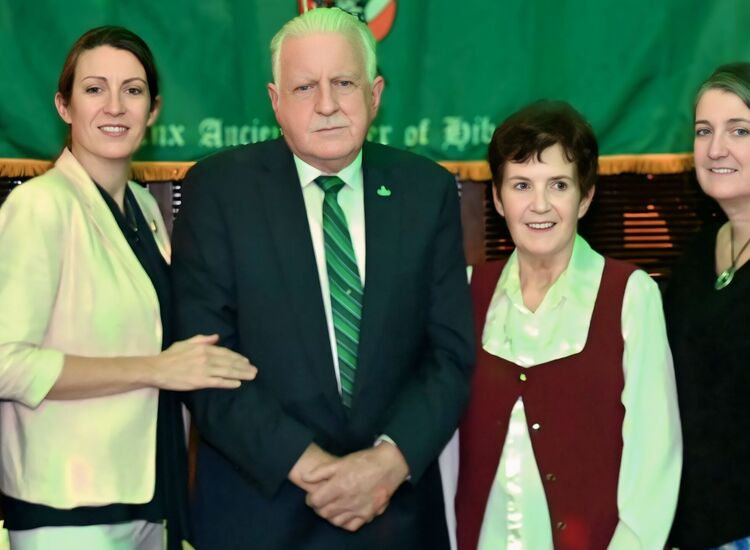By Ray O'Hanlon
"As best I remember, the following is my recollection."
The man who wrote down this simple opening sentence is named Robert P. Mentis and he lives in the town of Mount Vernon, Ohio.
What Mr. Mentis was doing his best to recall was the day when he took part in an assault on a hill during the Korean War, one of a seemingly endless number of hills on the Korean peninsula that came with nothing more than numbers attached to them.
This was Hill 281. The date was October 4, 1951. It was the day that Patrick Sheahan from Lixnaw, County Kerry would breathe his last.
Corporal Sheahan's story has been told before in this paper.
Sheahan won a Silver Star and a Bronze Star for his courage during what was extraordinarily bitter fighting even by the grim standards of twentieth century warfare.
Sheahan was one of 28 Irish-born members of the U.S. military killed during the three year war, the first shots in which will be remembered this Friday, June 25, the 60th anniversary of the war's beginning.
Sheahan was only made a U.S. citizen as recently as 2004, this after a decades long campaign led by another Lixnaw man and Korea veteran, John Leahy.
Leahy, since the awarding of posthumous citizenship and others has been waging a new campaign to secure for Sheahan a Congressional Medal of Honor.
Along with others, Leahy is of the view that Sheahan's lack of citizenship at the time of his death might have caused the authorities to deny him the country's highest award for bravery in the field.
One of the others is Senator Charles Schumer whose office has been beating a path through the bureaucratic maze that is the inevitable consequence when you try to change the record in so important a matter, and so many years after the fact.
The problem with regard to the case for Sheahan is that a fire in the early 1970s destroyed army records pertaining to Sheahan's death.
The official field report of his last day does exist. But it is a crisply written and formulaic account, the kind that was punched into a typewriter a time and distance from the fight.
Sheahan had won his Bronze Star in June of that year and along with it came a promotion to corporal. He was clearly not the kind of man to back down, or do things by half measure.
This is how the official report accounts for Sheahan's final action: "CORPORAL PATRICK SHEAHAN, US51064448, Infantry, Company "A", 7th Infantry, 3d Infantry Division, United States Army. On 4 October 1951, Company "A", with the First Platoon serving as the assault unit, attacked Hill 281 near Chungseri, Korea. Stiff enemy opposition prevailed and the sweeping fire of a hostile machine gun soon pinned down the platoon and halted the advance up the hill.
"Corporal SHEAHAN, realizing the gravity of the situation and aware that the enemy weapon must be neutralized, courageously crawled forward under the lethal hail of fire and completely destroyed the emplacement with accurately thrown hand grenades. Uncertain as to whether all the enemy soldiers had been killed by the explosions, he rose to his feet and, rushing forward, fired a long burst into the smashed entrenchment, eliminating all possible opposition.
"It was while thus revealed to the enemy, as he carried out his singlehandedly brave action that corporal SHEAHAN fell, mortally wounded by the savage fire of an adjacent automatic weapon. Corporal SHEAHAN'S aggressive gallantry and selfless devotion to duty were instrumental in the successful completion of his unit's mission and reflect the highest credit upon himself and the military service."
Robert Mentis was elsewhere in the hill at the time. But he would later set eyes on the body of a man who many now believe displayed a level of bravery worthy of the Medal of Honor.
"We were up in our staging area at 5 a.m. and we were about 1000 yards from the face of the hill," he recently wrote.
"we crossed a small stream and fanned out in an attack line. The artillery had already been firing for some time and we proceeded to assault the hill.
"The first platoon was the lead platoon and I am sure Pat was part of that platoon. Pat was, as I recall, the point man 'panel bearer' which meant he was out front in lead position. We were about three quarters of the way up the hill when out artillery lifted fire. The enemy now began laying heavy fire from the higher ground.
"The fighting continued for about five hours and all that time we drove the enemy from their bunkers and trenches. They still had snipers and while I was part of the sweep a sniper missed me twice. I dropped into a trench and waited for about five minutes and then continued on in the sweep. It was at that time that I saw Pat's body. There were two GIs standing near the body and I asked who is that since he was laying face down. One of the men said it was Pat Sheahan. I think the GI who answered was Corporal Brussard. Unfortunately, Brussard was killed on Hill 355 sometime later.
"I took a quick look and that is when I think I saw the panel beside the body. This is how I remember Pat Sheahan was killed on Hill 281, October 4, 1951 during the Korean War."
The statement is signed and notarized at the bottom.
There is more on Pat Sheahan and the other Irish Korean War U.S. soldiers who were made posthumous citizens at the Irish in Korea website, http://www.illyria.com/irishkor.html.









